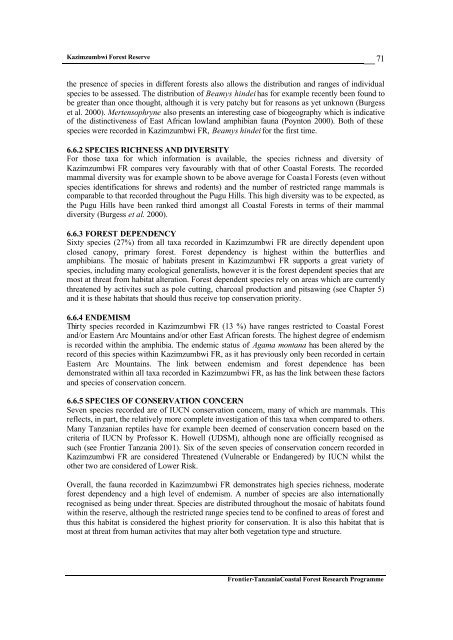Frontier Tanzania Environmental Research REPORT 110 ...
Frontier Tanzania Environmental Research REPORT 110 ...
Frontier Tanzania Environmental Research REPORT 110 ...
Create successful ePaper yourself
Turn your PDF publications into a flip-book with our unique Google optimized e-Paper software.
Kazimzumbwi Forest Reserve<br />
71<br />
the presence of species in different forests also allows the distribution and ranges of individual<br />
species to be assessed. The distribution of Beamys hindei has for example recently been found to<br />
be greater than once thought, although it is very patchy but for reasons as yet unknown (Burgess<br />
et al. 2000). Mertensophryne also presents an interesting case of biogeography which is indicative<br />
of the distinctiveness of East African lowland amphibian fauna (Poynton 2000). Both of these<br />
species were recorded in Kazimzumbwi FR, Beamys hindei for the first time.<br />
6.6.2 SPECIES RICHNESS AND DIVERSITY<br />
For those taxa for which information is available, the species richness and diversity of<br />
Kazimzumbwi FR compares very favourably with that of other Coastal Forests. The recorded<br />
mammal diversity was for example shown to be above average for Coasta l Forests (even without<br />
species identifications for shrews and rodents) and the number of restricted range mammals is<br />
comparable to that recorded throughout the Pugu Hills. This high diversity was to be expected, as<br />
the Pugu Hills have been ranked third amongst all Coastal Forests in terms of their mammal<br />
diversity (Burgess et al. 2000).<br />
6.6.3 FOREST DEPENDENCY<br />
Sixty species (27%) from all taxa recorded in Kazimzumbwi FR are directly dependent upon<br />
closed canopy, primary forest. Forest dependency is highest within the butterflies and<br />
amphibians. The mosaic of habitats present in Kazimzumbwi FR supports a great variety of<br />
species, including many ecological generalists, however it is the forest dependent species that are<br />
most at threat from habitat alteration. Forest dependent species rely on areas which are currently<br />
threatened by activites such as pole cutting, charcoal production and pitsawing (see Chapter 5)<br />
and it is these habitats that should thus receive top conservation priority.<br />
6.6.4 ENDEMISM<br />
Thirty species recorded in Kazimzumbwi FR (13 %) have ranges restricted to Coastal Forest<br />
and/or Eastern Arc Mountains and/or other East African forests. The highest degree of endemism<br />
is recorded within the amphibia. The endemic status of Agama montana has been altered by the<br />
record of this species within Kazimzumbwi FR, as it has previously only been recorded in certain<br />
Eastern Arc Mountains. The link between endemism and forest dependence has been<br />
demonstrated within all taxa recorded in Kazimzumbwi FR, as has the link between these factors<br />
and species of conservation concern.<br />
6.6.5 SPECIES OF CONSERVATION CONCERN<br />
Seven species recorded are of IUCN conservation concern, many of which are mammals. This<br />
reflects, in part, the relatively more complete investigation of this taxa when compared to others.<br />
Many <strong>Tanzania</strong>n reptiles have for example been deemed of conservation concern based on the<br />
criteria of IUCN by Professor K. Howell (UDSM), although none are officially recognised as<br />
such (see <strong>Frontier</strong> <strong>Tanzania</strong> 2001). Six of the seven species of conservation concern recorded in<br />
Kazimzumbwi FR are considered Threatened (Vulnerable or Endangered) by IUCN whilst the<br />
other two are considered of Lower Risk.<br />
Overall, the fauna recorded in Kazimzumbwi FR demonstrates high species richness, moderate<br />
forest dependency and a high level of endemism. A number of species are also internationally<br />
recognised as being under threat. Species are distributed throughout the mosaic of habitats found<br />
within the reserve, although the restricted range species tend to be confined to areas of forest and<br />
thus this habitat is considered the highest priority for conservation. It is also this habitat that is<br />
most at threat from human activites that may alter both vegetation type and structure.<br />
<strong>Frontier</strong>-<strong>Tanzania</strong>Coastal Forest <strong>Research</strong> Programme

















